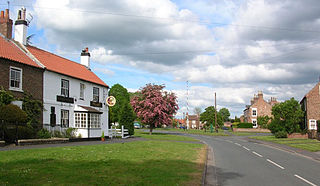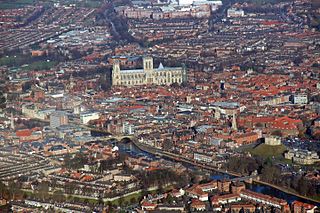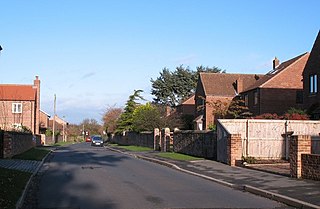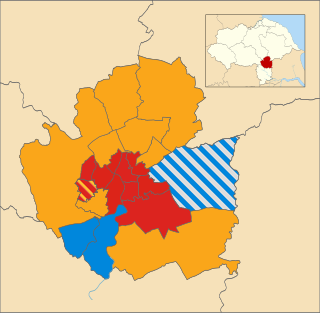
Acaster Malbis is a village and civil parish in the unitary authority of the City of York, England. It is located on the River Ouse, almost 5 miles (8 km) south of York. Nearby are the villages of Copmanthorpe 2 miles (3.2 km) to the north-west, Bishopthorpe 2 miles to the north and Appleton Roebuck 3.5 miles (6 km) to the south-west. The parish covers an area of about 2,000 acres (8.1 km2).

Askham Bryan is a village and civil parish in the unitary authority area of City of York in the north of England, 6 miles (10 km) south-west of York, west of Bishopthorpe, and close to Askham Richard and Copmanthorpe. According to the 2001 census the parish had a population of 582, reducing to 564 at the 2011 census.

Askham Richard is a village and civil parish in the unitary authority of City of York in the north of England, 6.5 miles (10.5 km) south-west of York, close to Copmanthorpe, Bilbrough and Askham Bryan. The population of the civil parish at the 2011 census was 351. The village became a Conservation Area in 1975. Nearby is Askham Bryan College of Agriculture.

Copmanthorpe is a village and civil parish in the City of York in the English county of North Yorkshire, 4 miles (6.4 km) south-west of York, west of Bishopthorpe and close to Acaster Malbis, Askham Bryan and Askham Richard. According to the 2001 census the parish had a population of 4,262, reducing to 4,173 at the 2011 Census.
Nether Poppleton is a village and civil parish in the unitary authority of the City of York in North Yorkshire, England. It is by the west bank of the River Ouse and is adjacent to Upper Poppleton west of York. It is close to the A59 road from York to Harrogate. The village is served by Poppleton railway station on the Harrogate Line.

Upper Poppleton is a village and civil parish in the unitary authority of the City of York in North Yorkshire, England. It is situated by the west bank of the River Ouse adjacent to Nether Poppleton, and west of York close to the A59 from York to Harrogate. The village is served by Poppleton railway station on the Harrogate Line. According to the 2001 census, the parish had a population of 1,961, increasing to 1,997 at the 2011 Census. Before 1996, it was part of the Borough of Harrogate.

Vale of York was a county constituency represented in the House of Commons of the Parliament of the United Kingdom. It elected one Member of Parliament (MP) by the first past the post system of election.
The Ainsty or the Ainsty of York was a historic district of Yorkshire, England, west of the city of York. Originally a wapentake or subdivision of the West Riding of Yorkshire it later had a unique status as a rural area controlled by the corporation of the city.
Elections to City of York Council were held on 6 May 1999. All 53 council seats in the city were up for election and the Labour Party kept overall control of the council.

The York park and ride is a park and ride network in the cathedral city of York, England, with sites operated by the City of York Council and bus services operated by First York. It is the largest park and ride network in the United Kingdom, with 4,970 car spaces across six sites: Askham Bar, Grimston Bar, Monks Cross, Poppleton Bar, Rawcliffe Bar and York Designer Outlet.
Elections to City of York Council were held in 2003. The whole council was up for election. Boundary changes had reduced the number of seats from 53 to 47.
Local elections for City of York Council were held on Thursday 3 May 2007. The whole council was up for election. Of the 47 seats contested, the Liberal Democrats won 19 seats, Labour won 18 seats, Conservatives won eight seats and the Green Party won two seats. The election saw York's ruling Liberal Democrats lose ten seats and overall control of the council.

The City of York is a unitary authority area with city status in the ceremonial county of North Yorkshire, England. The district's main settlement is York, and it extends to the surrounding area including the town of Haxby and the villages of Earswick, Upper Poppleton, Nether Poppleton, Copmanthorpe, Bishopthorpe, Dunnington, Stockton on the Forest, Rufforth, Askham Bryan and Askham Richard, among other villages and hamlets. The unitary area had a population of 202,800 in the 2021 Census The City of York is administered by the City of York Council based in The Guildhall.

Knapton is a village 3 miles (5 km) west of York in the City of York unitary authority area and ceremonial county of North Yorkshire, England. It is bounded by the village of Acomb to the east, the B1224 to the south, the A59 to the north and the A1237 York Outer Ring Road to the west.

Elections to City of York Council were held on Thursday 5 May 2011. The whole council was up for election. The vote took place alongside the 2011 United Kingdom Alternative Vote referendum.

The 2015 City of York Council election took place on 7 May 2015 to elect members of City of York Council in England. The whole council was up for election. Turnout was substantially up across the city due to the election being held on the same day as the general election and other local elections in England.
Elections to the new City of York unitary authority were held on 4 May 1995, although the new unitary authority wasn't officially created until April 1996. All 53 council seats in the city were up for election and the Labour Party won overall control of the council.

Elections to City of York Council were held on 2 May 2019, as part of the United Kingdom local elections. The election resulted in substantial gains for the Liberal Democrats, who became the largest party, although no party surpassed the 24-seat majority threshold. The Conservatives suffered badly in this election, and lost 12 of the 14 seats they had won at the previous election. The Green Party held all their four seats, and surpassed the Conservatives in the popular vote. Labour gained two seats, although they failed to gain support in rural areas, where voters favoured the Liberal Democrats. On 14 May, The Liberal Democrats and the Green Party announced that they had agreed to run the council in a new 'progressive partnership' coalition, with Green Party leader Andy D'Agorne assuming the role of Deputy Leader of the Council while Liberal Democrat leader Keith Aspden succeeded Ian Gillies as Leader of the Council.

Elections to City of York Council took place on 4 May 2023, as part of the United Kingdom local elections. They were held on the same day as other local elections in England. The incumbent leader of the council and leader of the Liberal Democrats, Keith Aspden did not stand for re-election, with it being announced ahead of the elections that Nigel Ayre would be the Liberal Democrats' new leader.













